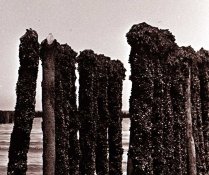It (my 30"x40" grainless print) was an FP4+ at ASA80 4x5 negative on Ilford Multigrade iv RC paper (roll) It was semi-stand processed in Pyrocat-P 1:1:150 for 55 minutes at 70F with 4 short agitations evenly spaced. It has a DR of 1.35. The SBR was about 7 stops. I used a condenser enlarger that I recently laser aligned (both carrier plane and lens plane) I focused it with a grain focus aid and developed it in PC-TEA. The sky is a zone 9 (just off the white) there are large areas of zone 5 -7 of bright rock that you can see small pebbles and sand on) - And it is grainless - I think an hour in pyro, stain likely masks any grain on the VC paper - I used a Grade 2 filter. I look at it every morning in the small room where I have it - ahem.
I too find that one can do huge grainless enlargements if there are textures present (such as the rocks you speak of). The Z9 sky wont show grain because it does not have the density on the print. I suspect that were the sky gently shifting Z5-7, such as ocercast, but interesting cloud variation, you would find plenty of grain at that size. I remember doing an exactol Lux test where I found utterly grainless skies"with the very high values and a seconds test sheet of a woodland scene wwas super sharp. Then I went to print my image Demise of teh Harvest Capella (if you look in my gallery youll see teh values I am talking about) and it wont go above 20"without break up in the delicate greys in the sky. That was processed with normal agitation too!
Early riser- I totally agree and think that most people here test for mottling and all the usal demons and come up with a technique that works before comitting important film. I find that with smoothies like Acros, that an acutance dev is the only way to get decent acutance and get some visual bite back. I am going to experiement with agitation every 2-3 mins for films like this. I remember comparing acros in DiXactol to that developed in ID11 and the DiXactol (which has very agressive acutance) produced a much more 3d image. For me, whatever I do has to be simple and reliable. I dont have the patience to wait 40 mins for some film! 20 mins tops! Using Pyrocat HD and agitating every second minute still introduces way more bite than regular devs and is no trouble at all apart from a slightly increased dev time.











